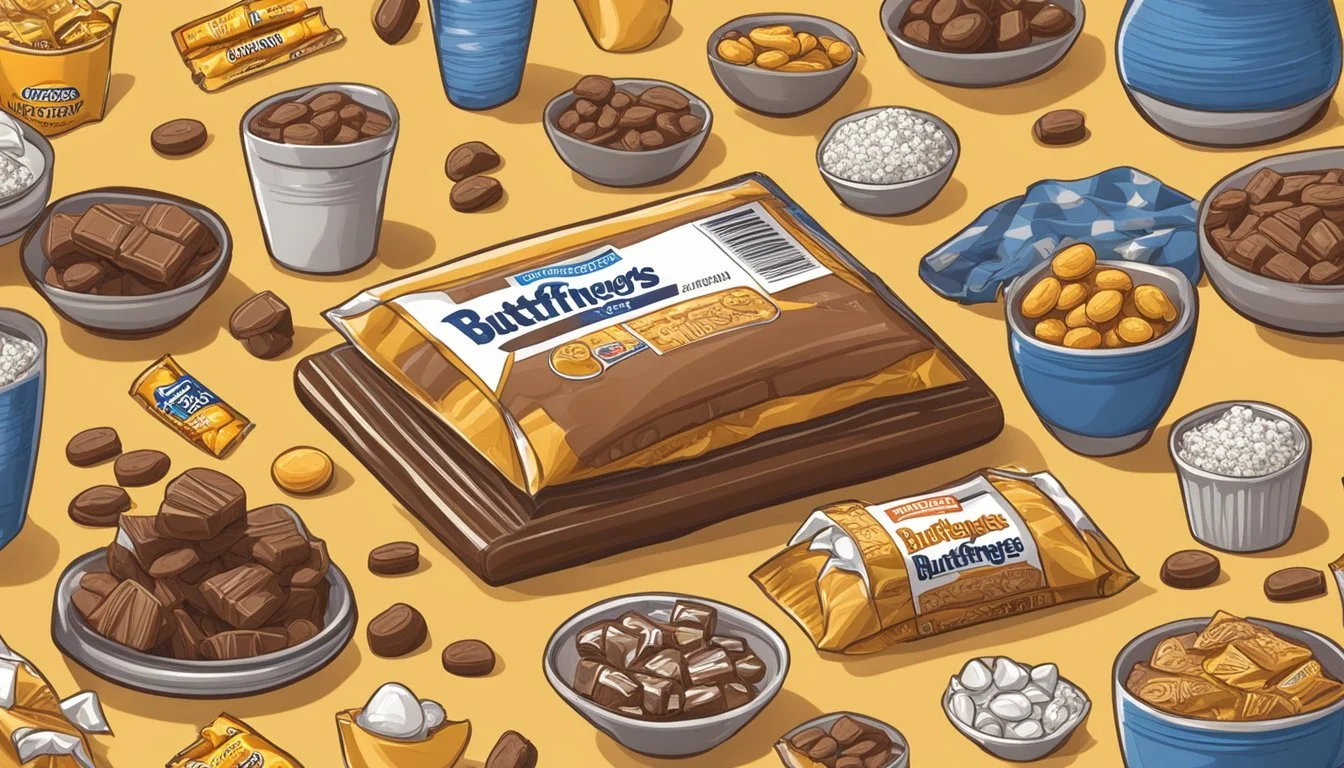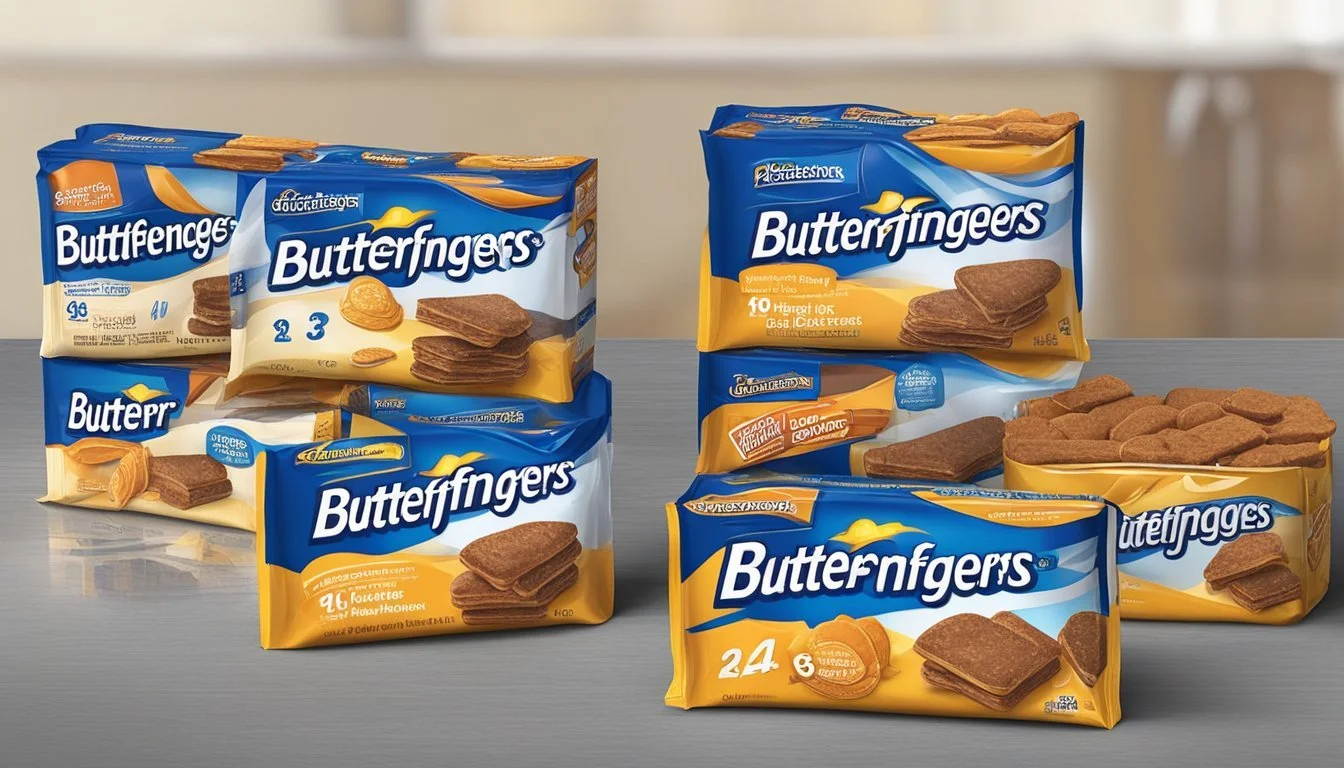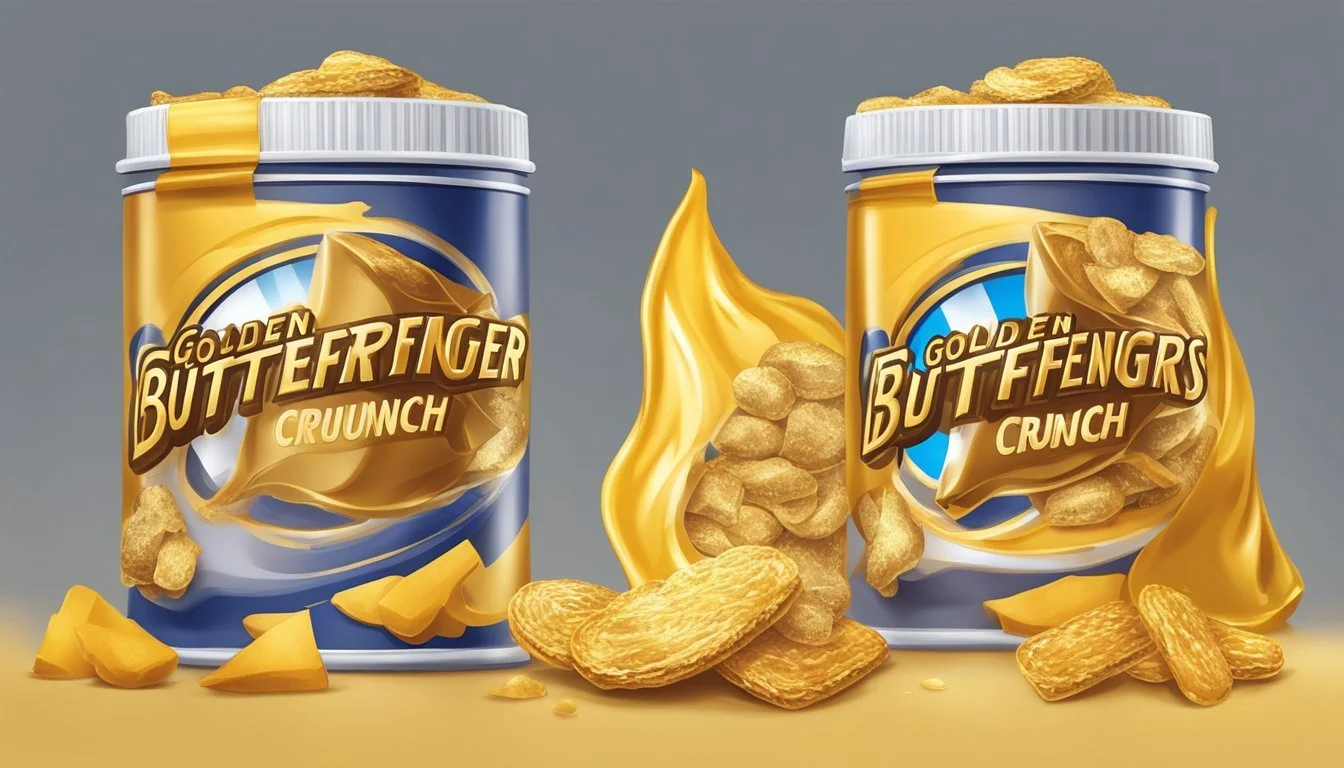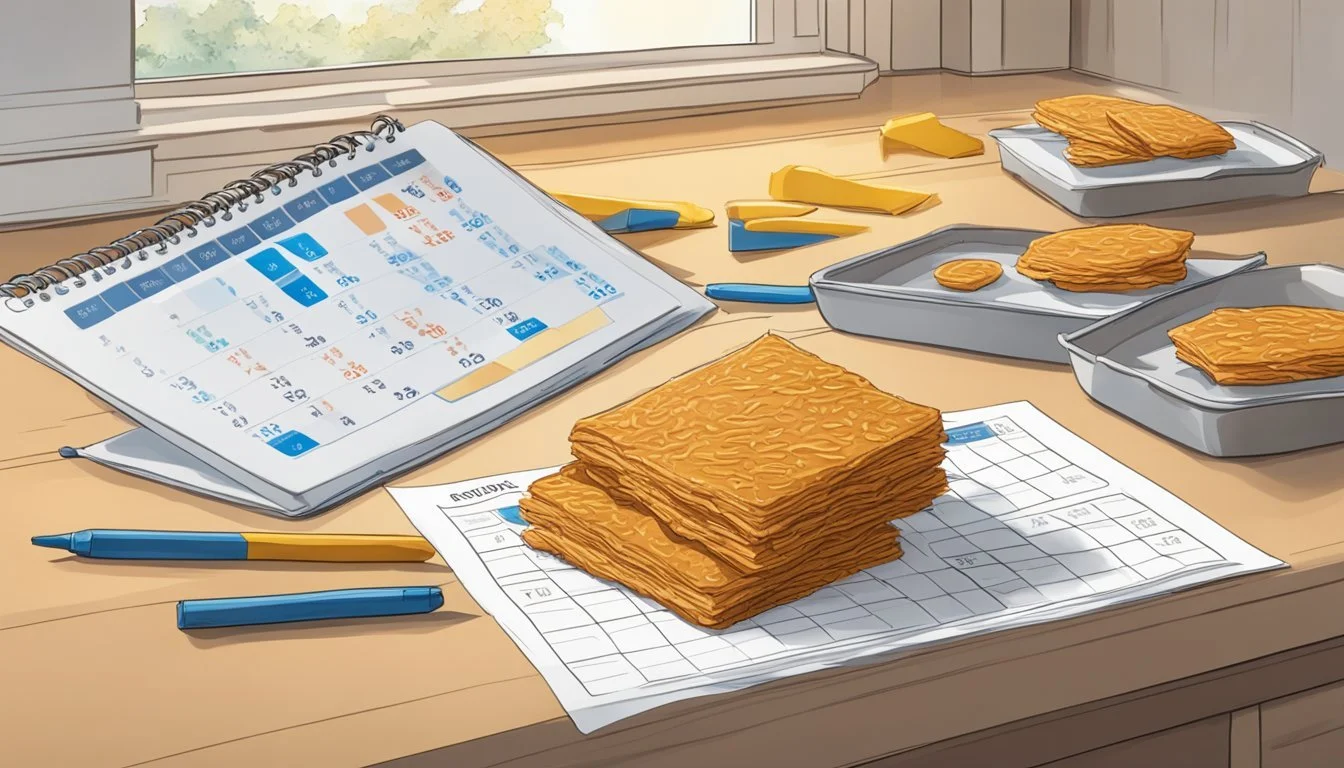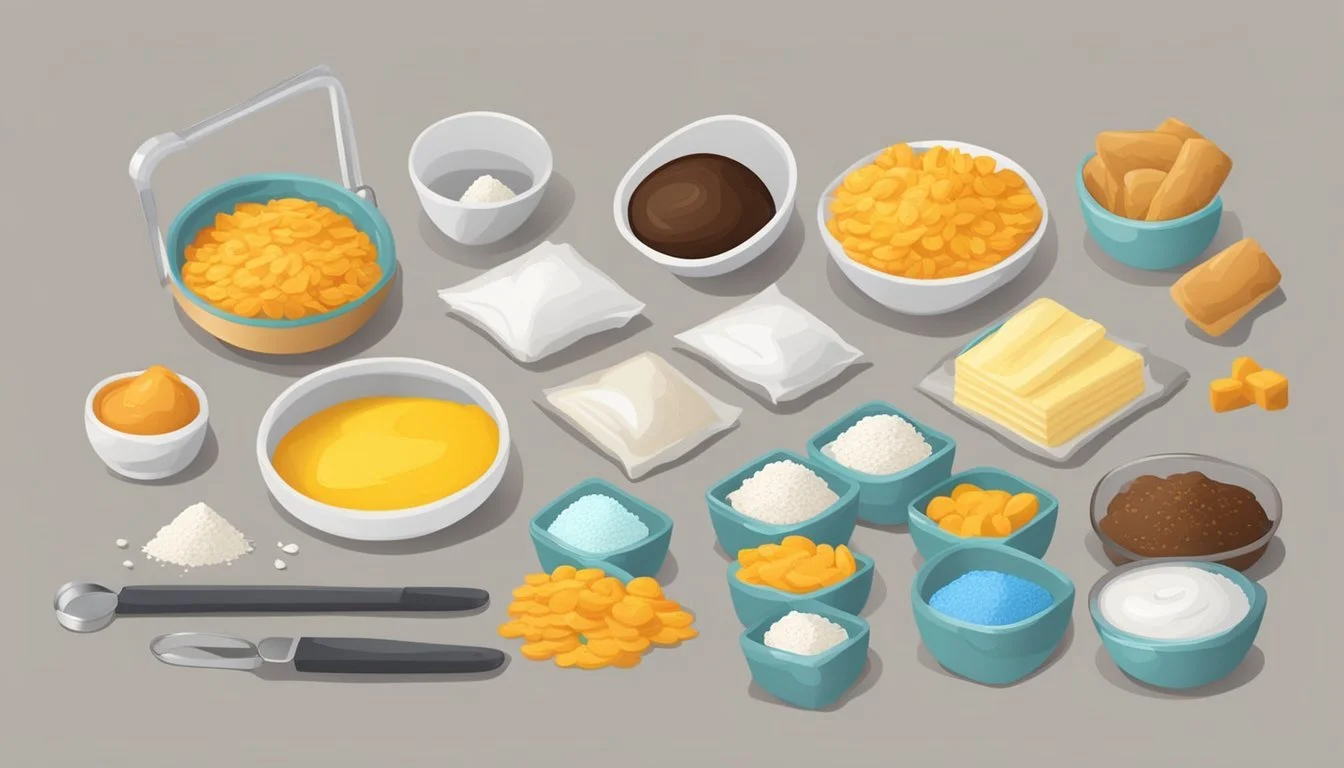How Long Do Butterfingers Last?
Shelf Life and Storage Tips
When considering the longevity of your favorite treats, Butterfinger bars come to mind. They are widely enjoyed for their crunchy, peanut buttery center and chocolatey exterior. Typically, a Butterfinger bar has a shelf life of around 10 months when stored under ideal conditions. Consumers should keep this in mind to ensure they are enjoying their candy bar at its best quality.
The best way to preserve the freshness of a Butterfinger is by storing it in a cool, dry place where the temperature is between 60-70 degrees Fahrenheit, away from direct heat and sunlight. Adhering to these storage guidelines can help maintain the candy bar's intended flavor and texture.
Interestingly, the recipe for Butterfinger underwent a change in January 2019. The reformulated product, which has been advertised as having an "improved recipe," supposedly features larger runner peanuts that are freshly roasted at the manufacturing plant. This enhancement is thought to have impacted the bar’s flavor and quality positively.
Butterfinger Overview
The Butterfinger candy bar, renowned for its unique, flaky peanut butter core enveloped in chocolate (What wine goes well with chocolate?), has navigated an interesting historical path and undergone brand evolution over the years.
Candy Bar History
In 1923, Otto Schnering, the founder of the Curtiss Candy Company, introduced the Butterfinger candy bar. This innovation in the confectionery market quickly resonated with consumers, establishing a notable presence. The candy bar distinguished itself with its characteristic crunchy texture made from a peanut butter center.
Brand Evolution
Butterfinger has changed ownership a few times, with Nestle acquiring the Curtiss Candy Company and subsequently, in 2018, Ferrero acquired Butterfinger from Nestle. Ferrero implemented a recipe change in January 2019, aiming to enhance the quality of the ingredients, including a shift to larger peanuts that are roasted in-house. Advertising strategies have been pivotal for Butterfinger, with campaigns featuring prominent cultural references, such as Shirley Temple and later, alignments with the animated series The Simpsons.
Ingredients and Nutritional Information
In this section, readers will find detailed information on the ingredients that make up a Butterfinger candy bar, as well as its nutritional content, to understand what this confection offers in terms of dietary value.
Candy Bar Composition
Ingredients:
Chocolate Coating: Made with cocoa, providing the rich chocolatey outer layer.
Filling: A combination of crunchy peanut butter and candy, giving the bar its signature texture.
Peanuts: Roasted peanuts are a primary ingredient, contributing to the protein content and flavor.
Sugar (how long does sugar last?): Present in a significant amount, accounting for the candy's sweetness.
Milk: Often included in the form of milk solids, contributing to the creaminess.
Fat: The bar includes fats, such as hydrogenated oils, which can affect texture and mouthfeel.
Saturated Fat: One of the types of fat present in the composition of the candy bar.
Cocoa: Used in the chocolate coating, providing flavor and antioxidants.
Caloric Content
Serving Size Calories Total Fat Saturated Fat Protein Carbohydrates Sugars Dietary Fiber 1.9 oz (54g) 250 10g 5g 3g 39g 24g 1g 2.1 oz (60g) 270-280 11g - 4g Approximately 40g Over 20g - 6.17 oz (174g) 799 33g - 9.4g 127g 80g 3.5g
Caloric values and nutritional breakdown can vary depending on the size of the Butterfinger candy bar. The information provided gives an overview of the different serving sizes and their respective caloric and nutrient content.
Homemade Butterfinger Preparation
Preparing homemade Butterfinger bars is a simple process that involves a few key steps using some common kitchen tools and ingredients. This section outlines a recipe and the necessary utensils to create these chocolate coated treats.
Butterfinger Recipe
One popular recipe for homemade Butterfinger bars calls for:
1 cup of candy corn
1 cup of creamy peanut butter
1 1/2 cups of chocolate wafers or melting chocolate chips
To start, melt the candy corn in a microwave-safe bowl until smooth, which typically takes about 90 seconds, stirring every 30 seconds. Once fully melted, quickly mix in the creamy peanut butter. Spread the mixture onto a baking sheet lined with parchment paper using a rolling pin to flatten. After chilling it in the refrigerator until it's set, use a sharp knife to cut the mixture into bars.
For the chocolate coating, melt the chocolate wafers in the microwave, stirring frequently until smooth. Using a fork, dip each homemade Butterfinger bar into the chocolate, ensuring all sides are covered. Allow them to set on parchment paper until the chocolate hardens.
Required Tools and Ingredients
To make homemade Butterfinger bars, one needs the following tools and ingredients:
Tools:
Microwave safe bowl
Baking sheet
Parchment paper
Rolling pin
Sharp knife
Fork
Ingredients:
Candy corn
Creamy peanut butter
Chocolate wafers or chips
Each bar should be stored in an airtight container to maintain freshness. Careful preparation and storage are key to enjoying homemade Butterfingers at their best.
Storage and Shelf Life
Butterfinger bars, with their crispety, crunchety, peanut-buttery texture, should be stored properly to maintain freshness. The key to preserving their quality is to keep them in a cool, dry place where the temperature ranges between 60-70 degrees F. Exposure to heat and sunlight can cause the chocolate to melt and the quality to degrade.
For optimum freshness, the bars should rest in an airtight container. This helps to prevent the introduction of moisture or other contaminants that can affect both texture and taste.
The preservative TBHQ (tertiary butylhydroquinone) may be present in Butterfinger products to maintain freshness. However, consumers should still adhere to the 10-month shelf life recommendation, starting from the date of production, to enjoy the product at its best quality.
Temperature Storage Suggestion 60-70 degrees F Cool, dry place Above 70 degrees F Airtight container
It's important to note that while the product can still be consumed after the 10 months, there may be noticeable changes in flavor and texture. Always check the bar for any unusual smell or appearance before consumption, as these can be indicators of spoilage.
Culinary Techniques
When creating confections like homemade Butterfingers, the approach to manipulating chocolate is crucial for texture and longevity. Properly melted and tempered chocolate can prevent blooming, where cocoa butter (how long does cocoa butter last?) separates, creating a white, powdery effect, thereby extending the shelf life of the candy.
Melting and Tempering Chocolate
Melting Chocolate: To melt chocolate, one can use a microwave or a pan. In a microwave, chocolate should be heated in short intervals, stirring in between to ensure even melting. Using a pan, one typically employs a double boiler method, where chocolate is placed in a bowl atop simmering water, ensuring indirect heat.
Tempering Chocolate: Tempering is a technique that involves cooling and heating chocolate to stabilize it for a smooth, glossy finish and a firm snap, which prolongs shelf life. This requires precise temperature control, making a candy thermometer vital for monitoring.
Melting Wafers: Chocolate melting wafers are an excellent choice for coating candies; they are designed to melt easily and have a consistent composition that negates the need for tempering.
Milk vs. Dark Chocolate: Milk chocolate melts at a lower temperature due to its milk solids and higher sugar content, whereas dark chocolate, with a higher cocoa content, requires higher temperatures to melt. For both types, slowly raising the temperature prevents overheating and ensures a smooth texture.
Sea Salt: (how long does sea salt last?) A pinch of sea salt can be added to melted chocolate to enhance flavor.
Table: Chocolate Tempering Temperatures
Chocolate Type Melting Point Tempering Range Milk Chocolate 86-88°F 84-86°F Dark Chocolate 88-90°F 86-88°F Chocolate Wafers --- Not required
Note: Temperatures in Fahrenheit. Chocolate Wafers do not require specific tempering ranges as they are formulated to set without tempering. Always refer to manufacturer's instructions for best results.
It's important for anyone working with chocolate to understand these factors to ensure that their candy retains optimal quality and a pleasing appearance.
Sensory Qualities
Recognizing the sensory characteristics of Butterfinger bars is pivotal in evaluating their shelf life. These elements include the flavor profile and texture consistency, which can be altered over time due to various factors like storage conditions.
Flavor Profile
Butterfingers are known for their distinct flavor, combining a sweet and nutty taste with a slight salty contrast. The peanut butter core contributes to this unique flavor profile, creating a balance between sweetness and the savory notes of peanuts.
Texture and Consistency
The texture of a Butterfinger is immediately noticeable upon first bite. It is defined by its:
Crunch: The bar's characteristic crunch is derived from the layered crisp texture.
Consistency: The core's cereal-like crispness resembles cornflakes, providing a satisfying snap.
Over time, these sensory qualities can deteriorate, affecting the overall snacking experience.
Crafting Variations
When preparing homemade Butterfingers, variations in the recipe can cater to specific dietary needs or explore creative flavor profiles. Experimenting with ingredients can yield delightful twists on the classic candy bar.
Alternative Recipes
Homemade Butterfingers traditionally call for candy corn, peanut butter, and chocolate coating. However, one can experiment with different types of chocolate, such as dark, milk, or even white chocolate, to alter the flavor dynamics. For a twist on the texture and taste, a Baby Ruth (how long does baby ruth last?) candy bar approach can be imitated by adding chopped peanuts or using a chunkier peanut butter. During Halloween, butterfinger bites disguised as spooky treats appeal to the festive spirit, simply by molding the mixture into ghost or pumpkin shapes before coating with chocolate.
Traditional Butterfinger Recipe: Candy corn, creamy peanut butter, chocolate coating
Alternative Chocolate Types: Dark, milk, or white chocolate
Baby Ruth Variation: Add chopped peanuts; use chunky peanut butter
Halloween Butterfinger Bites: Mold into festive shapes before coating
Dietary Adaptations
Individuals with gluten intolerance can enjoy gluten-free Butterfinger desserts by using gluten-free substitutes for any ingredients containing gluten. A careful selection of gluten-free candy corn is vital since not all brands are safe for those with celiac disease. For those who are lactose intolerant or allergic to milk, they can replace the milk chocolate with dairy-free chocolate alternatives. The flexibility of the homemade Butterfinger recipe allows for these adaptations without compromising the candy's signature crispety and crunchity experience.
Gluten-Free Adaptation: Utilize gluten-free candy corn and confirm all ingredients are gluten-free
Dairy-Free Alternative: Opt for dairy-free chocolate for coating
Cultural and Media Impact
Butterfinger has established itself as an icon in pop culture and media, permeating numerous cultural references and media mentions owing largely to its memorable flavor and marketing campaigns.
Prominent Brand Mentions
Otto Schnering, the founder of the Curtiss Candy Company, originally introduced Butterfinger, creating a brand that would become a staple in American confectionery history through strategic marketing and partnerships.
Shirley Temple famously mentioned Butterfinger in her films, further solidifying its place in cultural lore as a beloved candy bar from a young age.
Perhaps one of the most notable inclusions of Butterfinger in media is its recurring role in The Simpsons. Bart Simpson, an iconic character from the show, often proclaimed "Nobody better lay a finger on my Butterfinger!" as part of the candy's advertising campaign.
Beyond individual mentions, Butterfinger is also used in various comparative advertising strategies, drawing parallel to competitors like Twix (how long does twix last?), emphasizing its unique crispy and crunchy texture.
Through these media engagements, Butterfinger has not only kept itself in the public eye but has also adapted to changes in the market and ownership transitions from Nabisco to Standard Brands, and eventually to Ferrara, showcasing resilience and enduring presence.
Health Considerations
When exploring the longevity and storage of Butterfinger bars, one must also consider the health implications associated with consuming this candy. Specifically, the ingredients within Butterfingers can pose certain health risks if consumed in excess.
Ingredients to Be Cautious Of
Sugar: A primary ingredient in Butterfinger bars, high intake of sugar can lead to tooth decay and contribute to calorie excess. Butterfinger bars, like many candy bars, contain considerable amounts of sugar.
Fat: These candy bars also contain fat which can contribute to the total caloric content. Fat bloom, a whitish coating that can appear on the surface, is an indicator of fat migration but does not signify spoilage.
Saturated Fat: Butterfinger bars have saturated fats which, when consumed in high amounts, may raise a person's levels of “bad” LDL cholesterol.
Hydrogenated Oils: The presence of hydrogenated oils in Butterfingers indicates trans fats, which are recommended to be limited in the diet due to their negative impact on heart health.
Maintaining awareness of these ingredients and their effects on the body is crucial for consumers who are concerned about health, particularly in relation to sugar and fat intake.
DIY Butterfinger Projects
Creating homemade Butterfingers is a rewarding endeavor for those who enjoy crafting confectionery delights. The process not only allows for customization in terms of chocolate coatings but also the shape of the candy bars.
Homemade Butterfinger Crafts
Creating homemade Butterfingers provides a canvas for confections that channel the essence of standard brands while allowing for individual creativity.
Chocolate Coating Options:
Traditional Method: Melted milk chocolate is most commonly used, akin to the classic Butterfinger coating.
Variations: For a twist, one may choose white chocolate or dark chocolate to encase the candy or even employ vibrantly colored candy melts for a festive appearance.
Shaping the Candy:
Rectangular Molds: To replicate the quintessential Butterfinger shape, one might use rectangle molds.
Freeform Artistry: Without a mold, the crafter can shape their candy mixture by hand before chilling, leading to bars or even unique shapes as desired.
Creating homemade Butterfingers not only allows for the enjoyment of a nostalgic treat, but it also opens up the possibility of crafting candy bars that cater to personal preferences in flavor and presentation. Whether socializing at a party with crafted confections or enjoying a bar that rivals premium brands, homemade Butterfingers represent a delightful project.



